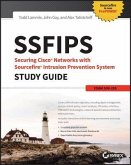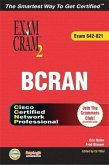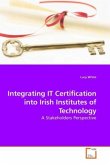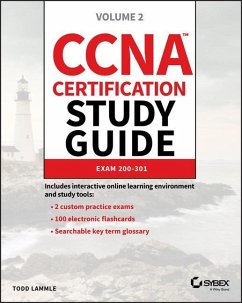- Broschiertes Buch
Andere Kunden interessierten sich auch für
 Todd LammleSsfips Securing Cisco Networks with Sourcefire Intrusion Prevention System Study Guide60,99 €
Todd LammleSsfips Securing Cisco Networks with Sourcefire Intrusion Prevention System Study Guide60,99 € Eric QuinnCCNP Bcran Exam Cram 227,99 €
Eric QuinnCCNP Bcran Exam Cram 227,99 € Sandra M. ReedHuman Resources Certification Kit108,99 €
Sandra M. ReedHuman Resources Certification Kit108,99 € International Handbook of Research in Medical Education416,99 €
International Handbook of Research in Medical Education416,99 € Melaine ShawAlternative Teacher Certification42,99 €
Melaine ShawAlternative Teacher Certification42,99 € Lucy WhiteIntegrating IT Certification into Irish Institutes of Technology56,99 €
Lucy WhiteIntegrating IT Certification into Irish Institutes of Technology56,99 € Bobbie JohnsPearson REVISE Key Stage 3 Maths Study Guide for preparing for GCSEs in 2025 and 2026: GCSE Preparation11,99 €
Bobbie JohnsPearson REVISE Key Stage 3 Maths Study Guide for preparing for GCSEs in 2025 and 2026: GCSE Preparation11,99 €-
-
-
Produktdetails
- Verlag: Wiley
- Seitenzahl: 896
- Erscheinungstermin: 11. Februar 2020
- Englisch
- Abmessung: 231mm x 188mm x 42mm
- Gewicht: 1423g
- ISBN-13: 9781119659181
- ISBN-10: 1119659183
- Artikelnr.: 57478584
Hinweis: Dieser Artikel kann nur an eine deutsche Lieferadresse ausgeliefert werden.
- Herstellerkennzeichnung
- Libri GmbH
- Europaallee 1
- 36244 Bad Hersfeld
- gpsr@libri.de
TODD LAMMLE, Cisco certified in almost every category, is the authority on Cisco networking and certification. His three decades of real-world experience is prevalent in his writing. He is an experienced networking engineer with very practical experience working on the largest bounded and unbounded networks in the world at such companies as Xerox, Hughes Aircraft, Texaco, AAA, Cisco, and Toshiba, among many others. Todd has published over 60 books, including the very popular and bestselling CCNA Cisco Certified Network Associate Study Guide and Cisco Firepower NGIPS. Todd runs an international training company from Texas, and a large-scale consulting business out of Colorado. You can reach Todd through his forum and blog at www.lammle.com/ccna.
Introduction xxv
Assessment Test xl
Chapter 1 Network Fundamentals 1
Network Components 2
Next-Generation Firewalls and IPS 6
Network Topology Architectures 10
Physical Interfaces and Cables 17
Ethernet Cabling 19
Summary 24
Exam Essentials 24
Review Questions 26
Chapter 2 TCP/IP 29
Introducing TCP/IP 30
TCP/IP and the DoD Model 31
IP Addressing 60
IPv4 Address Types 67
Summary 71
Exam Essentials 71
Review Questions 73
Chapter 3 Easy Subnetting 75
Subnetting Basics 76
Summary 102
Exam Essentials 102
Review Questions 103
Chapter 4 Troubleshooting IP Addressing 105
Cisco's Way of Troubleshooting IP 106
Summary 114
Exam Essentials 114
Review Questions 115
Chapter 5 IP Routing 117
Routing Basics 119
The IP Routing Process 121
Configuring IP Routing 132
Configuring IP Routing in Our Network 141
Dynamic Routing 150
Routing Information Protocol (RIP) 152
Summary 159
Exam Essentials 159
Review Questions 161
Chapter 6 Open Shortest Path First (OSPF) 163
Open Shortest Path First (OSPF) Basics 164
Configuring OSPF 171
OSPF and Loopback Interfaces 179
Verifying OSPF Configuration 182
Summary 188
Exam Essentials 188
Review Questions 189
Chapter 7 Layer 2 Switching 193
Switching Services 194
Configuring Catalyst Switches 204
Summary 215
Exam Essentials 215
Review Questions 216
Chapter 8 VLANs and Inter-VLAN Routing 219
VLAN Basics 220
Identifying VLANs 224
Routing Between VLANs 229
Configuring VLANs 231
Summary 247
Exam Essentials 247
Review Questions 248
Chapter 9 Enhanced Switched Technologies 251
Spanning Tree Protocol (STP) 252
Types of Spanning-Tree Protocols 259
Modifying and Verifying the Bridge ID 267
Spanning-Tree Failure Consequences 273
PortFast and BPDU Guard 275
EtherChannel 278
Summary 284
Exam Essentials 284
Review Questions 285
Chapter 10 Access Lists 289
Perimeter, Firewall, and Internal Routers 290
Introduction to Access Lists 291
Standard Access Lists 295
Extended Access Lists 303
Monitoring Access Lists 313
Summary 316
Exam Essentials 316
Review Questions 317
Chapter 11 Network Address Translation (NAT) 319
When Do We Use NAT? 320
Types of Network Address Translation 322
NAT Names 322
How NAT Works 323
Testing and Troubleshooting NAT 328
Summary 333
Exam Essentials 333
Review Questions 334
Chapter 12 IP Services 337
Exploring Connected Devices Using CDP and LLDP 338
Network Time Protocol (NTP) 347
SNMP 348
Syslog 352
Secure Shell (SSH) 357
Summary 358
Exam Essentials 358
Review Questions 360
Chapter 13 Security 363
Network Security Threats 365
Three Primary Network Attacks 365
Network Attacks 366
Security Program Elements 374
Layer 2 Security Features 378
Authentication Methods 381
Managing User Accounts 386
Security Password Policy Elements 389
User-Authentication Methods 398
Setting Passwords 400
Summary 407
Exam Essentials 407
Review Questions 408
Chapter 14 First Hop Redundancy Protocol (HSRP) 411
Client Redundancy Issues 412
Introducing First Hop Redundancy Protocol (FHRP) 414
Hot Standby Router Protocol (HSRP) 416
Summary 429
Exam Essentials 429
Review Questions 430
Chapter 15 Virtual Private Networks (VPNs) 433
Virtual Private Networks 434
GRE Tunnels 441
Summary 447
Exam Essentials 447
Review Questions 448
Chapter 16 Quality of Service (QoS) 451
Quality of Service 452
Trust Boundary 454
QoS Mechanisms 455
Summary 461
Exam Essentials 461
Review Questions 462
Chapter 17 Internet Protocol Version 6 (IPv6) 465
Why Do We Need IPv6? 467
The Benefits and Uses of IPv6 467
IPv6 Addressing and Expressions 469
How IPv6 Works in an Internetwork 473
IPv6 Routing Protocols 483
Configuring IPv6 on Our Internetwork 484
Configuring Routing on Our Internetwork 487
Summary 490
Exam Essentials 490
Review Questions 492
Chapter 18 Troubleshooting IP, IPv6, and VLANs 495
Endpoints 496
Servers 497
IP Config 498
Troubleshooting IP Network Connectivity 507
Troubleshooting IPv6 Network Connectivity 522
Troubleshooting VLAN Connectivity 531
Summary 544
Exam Essentials 545
Review Questions 546
Chapter 19 Wireless Technologies 549
Wireless Networks 551
Basic Wireless Devices 553
Wireless Principles 556
Nonoverlapping Wi-Fi channels 565
Radio Frequency (RF) 569
Wireless Security 581
Summary 588
Exam Essentials 588
Review Question 590
Chapter 20 Configuring Wireless Technologies 595
WLAN Deployment Models 596
Setting Up a Wireless LAN Controller (WLC) 602
Joining Access Points (APs) 607
Wireless LAN Controllers (WLC) 610
WLC Port Types 611
WLC Interface Types 614
AP Modes 629
AP and WLC Management Access Connections 633
Summary 655
Exam Essentials 655
Review Questions 657
Chapter 21 Virtualization, Automation, and Programmability 661
Virtual Machine Fundamentals 662
Virtualization Components 665
Virtualization Features 666
Virtualization Types 668
Virtualization Solutions 669
Automation Components 670
Summary 684
Exam Essentials 684
Review Questions 685
Chapter 22 SDN Controllers 689
Traditional Network Monitoring Systems (NMS) 690
Traditional Network Configuration Managers (NCM) 699
Traditional Networking 702
Introduction to SDN 706
Separating the Control Plane 709
Controller-Based Architectures 710
SDN Network Components 712
DNA Center Overview 718
Summary 736
Exam Essentials 737
Review Questions 738
Chapter 23 Configuration Management 743
Team Silos 744
DevOps 748
Infrastructure as Code (IaC) 748
Ansible 750
Ansible Tower/AWX 763
Puppet 764
Chef 772
Summary 781
Exam Essentials 782
Review Questions 783
Appendix Answer to Review Questions 787
Chapter 1: Network Fundamentals 788
Chapter 2: TCP/IP 788
Chapter 3: Easy Subnetting 789
Chapter 4: Troubleshooting IP Addressing 790
Chapter 5: IP Routing 791
Chapter 6: Open Shortest Path First (OSPF) 792
Chapter 7: Layer 2 Switching 792
Chapter 8: VLANs and Inter-VLAN Routing 794
Chapter 9: Enhanced Switched Technologies 795
Chapter 10: Access Lists 796
Chapter 11: Network Address Translation (NAT) 797
Chapter 12: IP Services 797
Chapter 13: Security 798
Chapter 14: First Hop Redundancy Protocol (HSRP) 799
Chapter 15: Virtual Private Networks (VPNs) 800
Chapter 16: Quality of Service (QoS) 801
Chapter 17: Internet Protocol Version 6 (IPv6) 802
Chapter 18: Troubleshooting IP, IPv6, and VLANs 803
Chapter 19: Wireless Technologies 803
Chapter 20: Configuring Wireless Technologies 805
Chapter 21: Virtualization, Automation, and Programmability 806
Chapter 22: SDN Controllers 806
Chapter 23: Configuration Management 808
Index 809
Assessment Test xl
Chapter 1 Network Fundamentals 1
Network Components 2
Next-Generation Firewalls and IPS 6
Network Topology Architectures 10
Physical Interfaces and Cables 17
Ethernet Cabling 19
Summary 24
Exam Essentials 24
Review Questions 26
Chapter 2 TCP/IP 29
Introducing TCP/IP 30
TCP/IP and the DoD Model 31
IP Addressing 60
IPv4 Address Types 67
Summary 71
Exam Essentials 71
Review Questions 73
Chapter 3 Easy Subnetting 75
Subnetting Basics 76
Summary 102
Exam Essentials 102
Review Questions 103
Chapter 4 Troubleshooting IP Addressing 105
Cisco's Way of Troubleshooting IP 106
Summary 114
Exam Essentials 114
Review Questions 115
Chapter 5 IP Routing 117
Routing Basics 119
The IP Routing Process 121
Configuring IP Routing 132
Configuring IP Routing in Our Network 141
Dynamic Routing 150
Routing Information Protocol (RIP) 152
Summary 159
Exam Essentials 159
Review Questions 161
Chapter 6 Open Shortest Path First (OSPF) 163
Open Shortest Path First (OSPF) Basics 164
Configuring OSPF 171
OSPF and Loopback Interfaces 179
Verifying OSPF Configuration 182
Summary 188
Exam Essentials 188
Review Questions 189
Chapter 7 Layer 2 Switching 193
Switching Services 194
Configuring Catalyst Switches 204
Summary 215
Exam Essentials 215
Review Questions 216
Chapter 8 VLANs and Inter-VLAN Routing 219
VLAN Basics 220
Identifying VLANs 224
Routing Between VLANs 229
Configuring VLANs 231
Summary 247
Exam Essentials 247
Review Questions 248
Chapter 9 Enhanced Switched Technologies 251
Spanning Tree Protocol (STP) 252
Types of Spanning-Tree Protocols 259
Modifying and Verifying the Bridge ID 267
Spanning-Tree Failure Consequences 273
PortFast and BPDU Guard 275
EtherChannel 278
Summary 284
Exam Essentials 284
Review Questions 285
Chapter 10 Access Lists 289
Perimeter, Firewall, and Internal Routers 290
Introduction to Access Lists 291
Standard Access Lists 295
Extended Access Lists 303
Monitoring Access Lists 313
Summary 316
Exam Essentials 316
Review Questions 317
Chapter 11 Network Address Translation (NAT) 319
When Do We Use NAT? 320
Types of Network Address Translation 322
NAT Names 322
How NAT Works 323
Testing and Troubleshooting NAT 328
Summary 333
Exam Essentials 333
Review Questions 334
Chapter 12 IP Services 337
Exploring Connected Devices Using CDP and LLDP 338
Network Time Protocol (NTP) 347
SNMP 348
Syslog 352
Secure Shell (SSH) 357
Summary 358
Exam Essentials 358
Review Questions 360
Chapter 13 Security 363
Network Security Threats 365
Three Primary Network Attacks 365
Network Attacks 366
Security Program Elements 374
Layer 2 Security Features 378
Authentication Methods 381
Managing User Accounts 386
Security Password Policy Elements 389
User-Authentication Methods 398
Setting Passwords 400
Summary 407
Exam Essentials 407
Review Questions 408
Chapter 14 First Hop Redundancy Protocol (HSRP) 411
Client Redundancy Issues 412
Introducing First Hop Redundancy Protocol (FHRP) 414
Hot Standby Router Protocol (HSRP) 416
Summary 429
Exam Essentials 429
Review Questions 430
Chapter 15 Virtual Private Networks (VPNs) 433
Virtual Private Networks 434
GRE Tunnels 441
Summary 447
Exam Essentials 447
Review Questions 448
Chapter 16 Quality of Service (QoS) 451
Quality of Service 452
Trust Boundary 454
QoS Mechanisms 455
Summary 461
Exam Essentials 461
Review Questions 462
Chapter 17 Internet Protocol Version 6 (IPv6) 465
Why Do We Need IPv6? 467
The Benefits and Uses of IPv6 467
IPv6 Addressing and Expressions 469
How IPv6 Works in an Internetwork 473
IPv6 Routing Protocols 483
Configuring IPv6 on Our Internetwork 484
Configuring Routing on Our Internetwork 487
Summary 490
Exam Essentials 490
Review Questions 492
Chapter 18 Troubleshooting IP, IPv6, and VLANs 495
Endpoints 496
Servers 497
IP Config 498
Troubleshooting IP Network Connectivity 507
Troubleshooting IPv6 Network Connectivity 522
Troubleshooting VLAN Connectivity 531
Summary 544
Exam Essentials 545
Review Questions 546
Chapter 19 Wireless Technologies 549
Wireless Networks 551
Basic Wireless Devices 553
Wireless Principles 556
Nonoverlapping Wi-Fi channels 565
Radio Frequency (RF) 569
Wireless Security 581
Summary 588
Exam Essentials 588
Review Question 590
Chapter 20 Configuring Wireless Technologies 595
WLAN Deployment Models 596
Setting Up a Wireless LAN Controller (WLC) 602
Joining Access Points (APs) 607
Wireless LAN Controllers (WLC) 610
WLC Port Types 611
WLC Interface Types 614
AP Modes 629
AP and WLC Management Access Connections 633
Summary 655
Exam Essentials 655
Review Questions 657
Chapter 21 Virtualization, Automation, and Programmability 661
Virtual Machine Fundamentals 662
Virtualization Components 665
Virtualization Features 666
Virtualization Types 668
Virtualization Solutions 669
Automation Components 670
Summary 684
Exam Essentials 684
Review Questions 685
Chapter 22 SDN Controllers 689
Traditional Network Monitoring Systems (NMS) 690
Traditional Network Configuration Managers (NCM) 699
Traditional Networking 702
Introduction to SDN 706
Separating the Control Plane 709
Controller-Based Architectures 710
SDN Network Components 712
DNA Center Overview 718
Summary 736
Exam Essentials 737
Review Questions 738
Chapter 23 Configuration Management 743
Team Silos 744
DevOps 748
Infrastructure as Code (IaC) 748
Ansible 750
Ansible Tower/AWX 763
Puppet 764
Chef 772
Summary 781
Exam Essentials 782
Review Questions 783
Appendix Answer to Review Questions 787
Chapter 1: Network Fundamentals 788
Chapter 2: TCP/IP 788
Chapter 3: Easy Subnetting 789
Chapter 4: Troubleshooting IP Addressing 790
Chapter 5: IP Routing 791
Chapter 6: Open Shortest Path First (OSPF) 792
Chapter 7: Layer 2 Switching 792
Chapter 8: VLANs and Inter-VLAN Routing 794
Chapter 9: Enhanced Switched Technologies 795
Chapter 10: Access Lists 796
Chapter 11: Network Address Translation (NAT) 797
Chapter 12: IP Services 797
Chapter 13: Security 798
Chapter 14: First Hop Redundancy Protocol (HSRP) 799
Chapter 15: Virtual Private Networks (VPNs) 800
Chapter 16: Quality of Service (QoS) 801
Chapter 17: Internet Protocol Version 6 (IPv6) 802
Chapter 18: Troubleshooting IP, IPv6, and VLANs 803
Chapter 19: Wireless Technologies 803
Chapter 20: Configuring Wireless Technologies 805
Chapter 21: Virtualization, Automation, and Programmability 806
Chapter 22: SDN Controllers 806
Chapter 23: Configuration Management 808
Index 809
Introduction xxv
Assessment Test xl
Chapter 1 Network Fundamentals 1
Network Components 2
Next-Generation Firewalls and IPS 6
Network Topology Architectures 10
Physical Interfaces and Cables 17
Ethernet Cabling 19
Summary 24
Exam Essentials 24
Review Questions 26
Chapter 2 TCP/IP 29
Introducing TCP/IP 30
TCP/IP and the DoD Model 31
IP Addressing 60
IPv4 Address Types 67
Summary 71
Exam Essentials 71
Review Questions 73
Chapter 3 Easy Subnetting 75
Subnetting Basics 76
Summary 102
Exam Essentials 102
Review Questions 103
Chapter 4 Troubleshooting IP Addressing 105
Cisco's Way of Troubleshooting IP 106
Summary 114
Exam Essentials 114
Review Questions 115
Chapter 5 IP Routing 117
Routing Basics 119
The IP Routing Process 121
Configuring IP Routing 132
Configuring IP Routing in Our Network 141
Dynamic Routing 150
Routing Information Protocol (RIP) 152
Summary 159
Exam Essentials 159
Review Questions 161
Chapter 6 Open Shortest Path First (OSPF) 163
Open Shortest Path First (OSPF) Basics 164
Configuring OSPF 171
OSPF and Loopback Interfaces 179
Verifying OSPF Configuration 182
Summary 188
Exam Essentials 188
Review Questions 189
Chapter 7 Layer 2 Switching 193
Switching Services 194
Configuring Catalyst Switches 204
Summary 215
Exam Essentials 215
Review Questions 216
Chapter 8 VLANs and Inter-VLAN Routing 219
VLAN Basics 220
Identifying VLANs 224
Routing Between VLANs 229
Configuring VLANs 231
Summary 247
Exam Essentials 247
Review Questions 248
Chapter 9 Enhanced Switched Technologies 251
Spanning Tree Protocol (STP) 252
Types of Spanning-Tree Protocols 259
Modifying and Verifying the Bridge ID 267
Spanning-Tree Failure Consequences 273
PortFast and BPDU Guard 275
EtherChannel 278
Summary 284
Exam Essentials 284
Review Questions 285
Chapter 10 Access Lists 289
Perimeter, Firewall, and Internal Routers 290
Introduction to Access Lists 291
Standard Access Lists 295
Extended Access Lists 303
Monitoring Access Lists 313
Summary 316
Exam Essentials 316
Review Questions 317
Chapter 11 Network Address Translation (NAT) 319
When Do We Use NAT? 320
Types of Network Address Translation 322
NAT Names 322
How NAT Works 323
Testing and Troubleshooting NAT 328
Summary 333
Exam Essentials 333
Review Questions 334
Chapter 12 IP Services 337
Exploring Connected Devices Using CDP and LLDP 338
Network Time Protocol (NTP) 347
SNMP 348
Syslog 352
Secure Shell (SSH) 357
Summary 358
Exam Essentials 358
Review Questions 360
Chapter 13 Security 363
Network Security Threats 365
Three Primary Network Attacks 365
Network Attacks 366
Security Program Elements 374
Layer 2 Security Features 378
Authentication Methods 381
Managing User Accounts 386
Security Password Policy Elements 389
User-Authentication Methods 398
Setting Passwords 400
Summary 407
Exam Essentials 407
Review Questions 408
Chapter 14 First Hop Redundancy Protocol (HSRP) 411
Client Redundancy Issues 412
Introducing First Hop Redundancy Protocol (FHRP) 414
Hot Standby Router Protocol (HSRP) 416
Summary 429
Exam Essentials 429
Review Questions 430
Chapter 15 Virtual Private Networks (VPNs) 433
Virtual Private Networks 434
GRE Tunnels 441
Summary 447
Exam Essentials 447
Review Questions 448
Chapter 16 Quality of Service (QoS) 451
Quality of Service 452
Trust Boundary 454
QoS Mechanisms 455
Summary 461
Exam Essentials 461
Review Questions 462
Chapter 17 Internet Protocol Version 6 (IPv6) 465
Why Do We Need IPv6? 467
The Benefits and Uses of IPv6 467
IPv6 Addressing and Expressions 469
How IPv6 Works in an Internetwork 473
IPv6 Routing Protocols 483
Configuring IPv6 on Our Internetwork 484
Configuring Routing on Our Internetwork 487
Summary 490
Exam Essentials 490
Review Questions 492
Chapter 18 Troubleshooting IP, IPv6, and VLANs 495
Endpoints 496
Servers 497
IP Config 498
Troubleshooting IP Network Connectivity 507
Troubleshooting IPv6 Network Connectivity 522
Troubleshooting VLAN Connectivity 531
Summary 544
Exam Essentials 545
Review Questions 546
Chapter 19 Wireless Technologies 549
Wireless Networks 551
Basic Wireless Devices 553
Wireless Principles 556
Nonoverlapping Wi-Fi channels 565
Radio Frequency (RF) 569
Wireless Security 581
Summary 588
Exam Essentials 588
Review Question 590
Chapter 20 Configuring Wireless Technologies 595
WLAN Deployment Models 596
Setting Up a Wireless LAN Controller (WLC) 602
Joining Access Points (APs) 607
Wireless LAN Controllers (WLC) 610
WLC Port Types 611
WLC Interface Types 614
AP Modes 629
AP and WLC Management Access Connections 633
Summary 655
Exam Essentials 655
Review Questions 657
Chapter 21 Virtualization, Automation, and Programmability 661
Virtual Machine Fundamentals 662
Virtualization Components 665
Virtualization Features 666
Virtualization Types 668
Virtualization Solutions 669
Automation Components 670
Summary 684
Exam Essentials 684
Review Questions 685
Chapter 22 SDN Controllers 689
Traditional Network Monitoring Systems (NMS) 690
Traditional Network Configuration Managers (NCM) 699
Traditional Networking 702
Introduction to SDN 706
Separating the Control Plane 709
Controller-Based Architectures 710
SDN Network Components 712
DNA Center Overview 718
Summary 736
Exam Essentials 737
Review Questions 738
Chapter 23 Configuration Management 743
Team Silos 744
DevOps 748
Infrastructure as Code (IaC) 748
Ansible 750
Ansible Tower/AWX 763
Puppet 764
Chef 772
Summary 781
Exam Essentials 782
Review Questions 783
Appendix Answer to Review Questions 787
Chapter 1: Network Fundamentals 788
Chapter 2: TCP/IP 788
Chapter 3: Easy Subnetting 789
Chapter 4: Troubleshooting IP Addressing 790
Chapter 5: IP Routing 791
Chapter 6: Open Shortest Path First (OSPF) 792
Chapter 7: Layer 2 Switching 792
Chapter 8: VLANs and Inter-VLAN Routing 794
Chapter 9: Enhanced Switched Technologies 795
Chapter 10: Access Lists 796
Chapter 11: Network Address Translation (NAT) 797
Chapter 12: IP Services 797
Chapter 13: Security 798
Chapter 14: First Hop Redundancy Protocol (HSRP) 799
Chapter 15: Virtual Private Networks (VPNs) 800
Chapter 16: Quality of Service (QoS) 801
Chapter 17: Internet Protocol Version 6 (IPv6) 802
Chapter 18: Troubleshooting IP, IPv6, and VLANs 803
Chapter 19: Wireless Technologies 803
Chapter 20: Configuring Wireless Technologies 805
Chapter 21: Virtualization, Automation, and Programmability 806
Chapter 22: SDN Controllers 806
Chapter 23: Configuration Management 808
Index 809
Assessment Test xl
Chapter 1 Network Fundamentals 1
Network Components 2
Next-Generation Firewalls and IPS 6
Network Topology Architectures 10
Physical Interfaces and Cables 17
Ethernet Cabling 19
Summary 24
Exam Essentials 24
Review Questions 26
Chapter 2 TCP/IP 29
Introducing TCP/IP 30
TCP/IP and the DoD Model 31
IP Addressing 60
IPv4 Address Types 67
Summary 71
Exam Essentials 71
Review Questions 73
Chapter 3 Easy Subnetting 75
Subnetting Basics 76
Summary 102
Exam Essentials 102
Review Questions 103
Chapter 4 Troubleshooting IP Addressing 105
Cisco's Way of Troubleshooting IP 106
Summary 114
Exam Essentials 114
Review Questions 115
Chapter 5 IP Routing 117
Routing Basics 119
The IP Routing Process 121
Configuring IP Routing 132
Configuring IP Routing in Our Network 141
Dynamic Routing 150
Routing Information Protocol (RIP) 152
Summary 159
Exam Essentials 159
Review Questions 161
Chapter 6 Open Shortest Path First (OSPF) 163
Open Shortest Path First (OSPF) Basics 164
Configuring OSPF 171
OSPF and Loopback Interfaces 179
Verifying OSPF Configuration 182
Summary 188
Exam Essentials 188
Review Questions 189
Chapter 7 Layer 2 Switching 193
Switching Services 194
Configuring Catalyst Switches 204
Summary 215
Exam Essentials 215
Review Questions 216
Chapter 8 VLANs and Inter-VLAN Routing 219
VLAN Basics 220
Identifying VLANs 224
Routing Between VLANs 229
Configuring VLANs 231
Summary 247
Exam Essentials 247
Review Questions 248
Chapter 9 Enhanced Switched Technologies 251
Spanning Tree Protocol (STP) 252
Types of Spanning-Tree Protocols 259
Modifying and Verifying the Bridge ID 267
Spanning-Tree Failure Consequences 273
PortFast and BPDU Guard 275
EtherChannel 278
Summary 284
Exam Essentials 284
Review Questions 285
Chapter 10 Access Lists 289
Perimeter, Firewall, and Internal Routers 290
Introduction to Access Lists 291
Standard Access Lists 295
Extended Access Lists 303
Monitoring Access Lists 313
Summary 316
Exam Essentials 316
Review Questions 317
Chapter 11 Network Address Translation (NAT) 319
When Do We Use NAT? 320
Types of Network Address Translation 322
NAT Names 322
How NAT Works 323
Testing and Troubleshooting NAT 328
Summary 333
Exam Essentials 333
Review Questions 334
Chapter 12 IP Services 337
Exploring Connected Devices Using CDP and LLDP 338
Network Time Protocol (NTP) 347
SNMP 348
Syslog 352
Secure Shell (SSH) 357
Summary 358
Exam Essentials 358
Review Questions 360
Chapter 13 Security 363
Network Security Threats 365
Three Primary Network Attacks 365
Network Attacks 366
Security Program Elements 374
Layer 2 Security Features 378
Authentication Methods 381
Managing User Accounts 386
Security Password Policy Elements 389
User-Authentication Methods 398
Setting Passwords 400
Summary 407
Exam Essentials 407
Review Questions 408
Chapter 14 First Hop Redundancy Protocol (HSRP) 411
Client Redundancy Issues 412
Introducing First Hop Redundancy Protocol (FHRP) 414
Hot Standby Router Protocol (HSRP) 416
Summary 429
Exam Essentials 429
Review Questions 430
Chapter 15 Virtual Private Networks (VPNs) 433
Virtual Private Networks 434
GRE Tunnels 441
Summary 447
Exam Essentials 447
Review Questions 448
Chapter 16 Quality of Service (QoS) 451
Quality of Service 452
Trust Boundary 454
QoS Mechanisms 455
Summary 461
Exam Essentials 461
Review Questions 462
Chapter 17 Internet Protocol Version 6 (IPv6) 465
Why Do We Need IPv6? 467
The Benefits and Uses of IPv6 467
IPv6 Addressing and Expressions 469
How IPv6 Works in an Internetwork 473
IPv6 Routing Protocols 483
Configuring IPv6 on Our Internetwork 484
Configuring Routing on Our Internetwork 487
Summary 490
Exam Essentials 490
Review Questions 492
Chapter 18 Troubleshooting IP, IPv6, and VLANs 495
Endpoints 496
Servers 497
IP Config 498
Troubleshooting IP Network Connectivity 507
Troubleshooting IPv6 Network Connectivity 522
Troubleshooting VLAN Connectivity 531
Summary 544
Exam Essentials 545
Review Questions 546
Chapter 19 Wireless Technologies 549
Wireless Networks 551
Basic Wireless Devices 553
Wireless Principles 556
Nonoverlapping Wi-Fi channels 565
Radio Frequency (RF) 569
Wireless Security 581
Summary 588
Exam Essentials 588
Review Question 590
Chapter 20 Configuring Wireless Technologies 595
WLAN Deployment Models 596
Setting Up a Wireless LAN Controller (WLC) 602
Joining Access Points (APs) 607
Wireless LAN Controllers (WLC) 610
WLC Port Types 611
WLC Interface Types 614
AP Modes 629
AP and WLC Management Access Connections 633
Summary 655
Exam Essentials 655
Review Questions 657
Chapter 21 Virtualization, Automation, and Programmability 661
Virtual Machine Fundamentals 662
Virtualization Components 665
Virtualization Features 666
Virtualization Types 668
Virtualization Solutions 669
Automation Components 670
Summary 684
Exam Essentials 684
Review Questions 685
Chapter 22 SDN Controllers 689
Traditional Network Monitoring Systems (NMS) 690
Traditional Network Configuration Managers (NCM) 699
Traditional Networking 702
Introduction to SDN 706
Separating the Control Plane 709
Controller-Based Architectures 710
SDN Network Components 712
DNA Center Overview 718
Summary 736
Exam Essentials 737
Review Questions 738
Chapter 23 Configuration Management 743
Team Silos 744
DevOps 748
Infrastructure as Code (IaC) 748
Ansible 750
Ansible Tower/AWX 763
Puppet 764
Chef 772
Summary 781
Exam Essentials 782
Review Questions 783
Appendix Answer to Review Questions 787
Chapter 1: Network Fundamentals 788
Chapter 2: TCP/IP 788
Chapter 3: Easy Subnetting 789
Chapter 4: Troubleshooting IP Addressing 790
Chapter 5: IP Routing 791
Chapter 6: Open Shortest Path First (OSPF) 792
Chapter 7: Layer 2 Switching 792
Chapter 8: VLANs and Inter-VLAN Routing 794
Chapter 9: Enhanced Switched Technologies 795
Chapter 10: Access Lists 796
Chapter 11: Network Address Translation (NAT) 797
Chapter 12: IP Services 797
Chapter 13: Security 798
Chapter 14: First Hop Redundancy Protocol (HSRP) 799
Chapter 15: Virtual Private Networks (VPNs) 800
Chapter 16: Quality of Service (QoS) 801
Chapter 17: Internet Protocol Version 6 (IPv6) 802
Chapter 18: Troubleshooting IP, IPv6, and VLANs 803
Chapter 19: Wireless Technologies 803
Chapter 20: Configuring Wireless Technologies 805
Chapter 21: Virtualization, Automation, and Programmability 806
Chapter 22: SDN Controllers 806
Chapter 23: Configuration Management 808
Index 809

